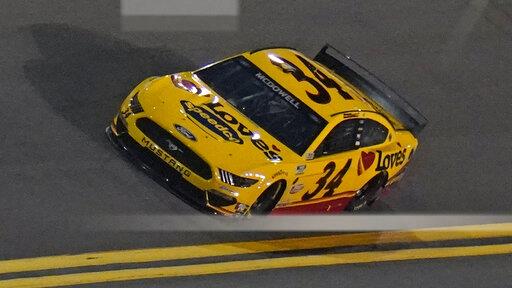NASCAR – Daytona 500 represents a timeless American tradition

Photo Courtesy of Chris O’Meara/AP Images
The first victory of Michael McDowell’s 14-year career came at 2021 Daytona 500, the most prestigious race in NASCAR.
February 19, 2021
On February 14, the National Association for Stock Car Auto Racing (NASCAR) held its 63rd Annual Daytona 500. The Daytona 500 is widely regarded as the most prestigious race in the NASCAR season and consists of 200 laps around a two and a half mile oval track. In many parts of the country, the Daytona 500 is a highly anticipated event, with last year’s race generating 7.3 million television viewers, according to the Daytona Beach News-Journal.
The first Daytona 500 was held in 1959, when 59 cars raced for an audience of over 41,000 people. The race was so close that it took three days for NASCAR to announce Richard Petty the first ever Daytona 500 winner over Johnny Beauchamp. The race lasted a total of three hours 41 minutes and 22 seconds.
The delay in announcing the winner helped the new race gain publicity and attention, but the popularity was short-lived. The next year, attendance was down by over 3,000 people, and NASCAR races today remain one of most poorly attended sporting events in the United States. It gained attention in the early 2000s, following the shocking death of Dale Earnhardt Sr. in 2001, with live attendance of the Daytona 500 reaching a record high of over 200,000 as reported by the Daytona Beach News-Journal.
One of the most unusual dangers NASCAR racing poses is the possibility of spectator injury. The Talladega Speedway in Alabama has been home to several disastrous crashes in which fans were sent to the hospital for their injuries, perhaps the most well known being the Carl Edwards crash in 2009, where seven fans were hurt.
Although no spectator has ever died at a NASCAR event, the National Institute of Health has found that automobile and motorcycle racing in general has significantly more spectator injuries than any other sport.
Most accidents, crashes, and injuries occur during the last few laps of any race, including the Daytona 500. Due to the repetitive nature of the race, the last few laps are considered the most important, and therefore account for the highest numbers of television viewers. Many Daytona 500 winners throughout history have even come into the last lap in second or third place, only to pull ahead in the final moments of the race.
Nearly all Daytona 500 outcomes in recent history have been a close call, but the closest margin of victory occurred in 2016. Denny Hamlin took the lead during the final lap, passing the finish line just .01 seconds before Martin Truex Jr. The 2021 Daytona 500 saw winner Michael McDowell take the lead on the final lap by avoiding a 16 car crash among the lead cars.
NASCAR racing remains a remarkably unchanged sport since its opening, as clearly seen in Daytona 500 winners, all of whom are white men. No woman even qualified for the Daytona 500 until 1977, when Janet Guthrie came in 12th place as a result of her car’s engine blowing two cylinders with ten laps left in the race.
In 2016, Tia Norfleet became the first black female NASCAR driver, but she never reached the Daytona 500. As recently as 2019, Brehanna Daniels was the only black woman to ever be at the Daytona 500 as a part of the pit crew. The most recent Daytona 500 saw the first African-American driver to ever lead a lap in the storied race, achieved by Bubba Wallace.
With NASCAR remaining fairly unchanged since its starting days, the Daytona 500 represents a seemingly timeless tradition for thousands of fans all across the country. From accidents to nail biters, the Daytona 500 is a race that combines uniformity with occasional tension that puts fans on the edge of their seats.


